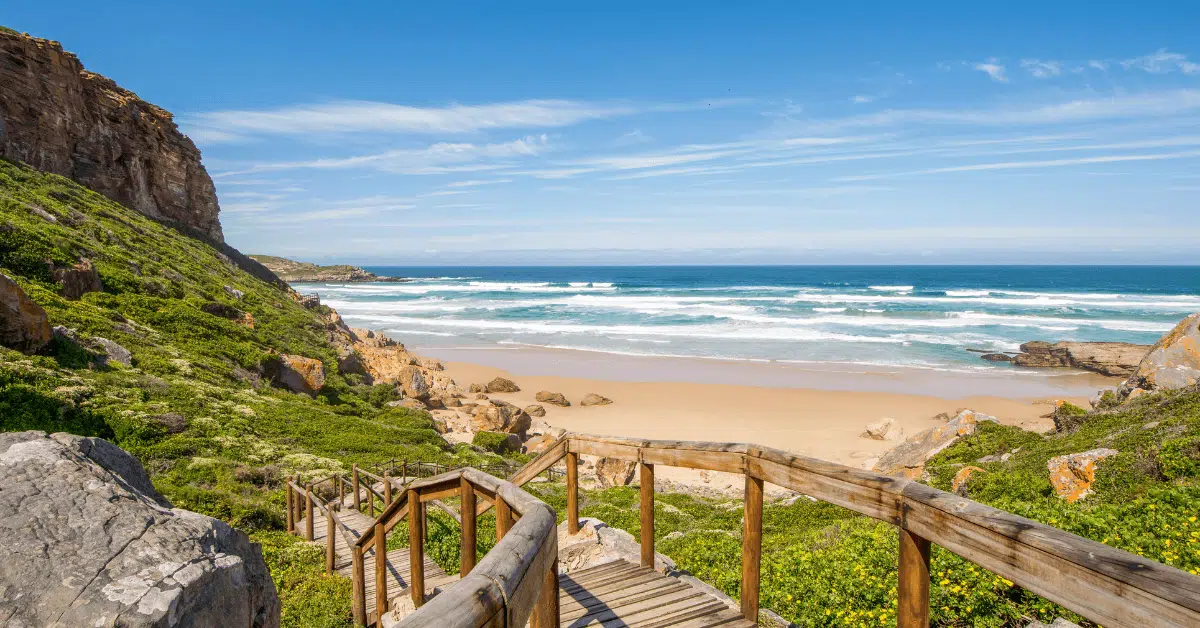7 Perfect South America Backpacking Routes (For Every Traveler)
Move over Southeast Asia and Europe: South America is the new backpacking hotspot. Backpacking South America, though underrated, is an experience that has everything you could ever ask for as a backpacker – the inexpensive cost of travel, incredible natural wonders, bustling cities, nightlife, culture and history, and so much more.
This ultimate guide to South America backpacking routes includes experienced travelers’ own tried-and-tested South America backpacking itineraries for you to try as well. South America is so vast, and there is no one South America backpacking route that stands supreme, but shorter ones that cross countries and regions in weeks and months – choose from among these for the experience of a lifetime.
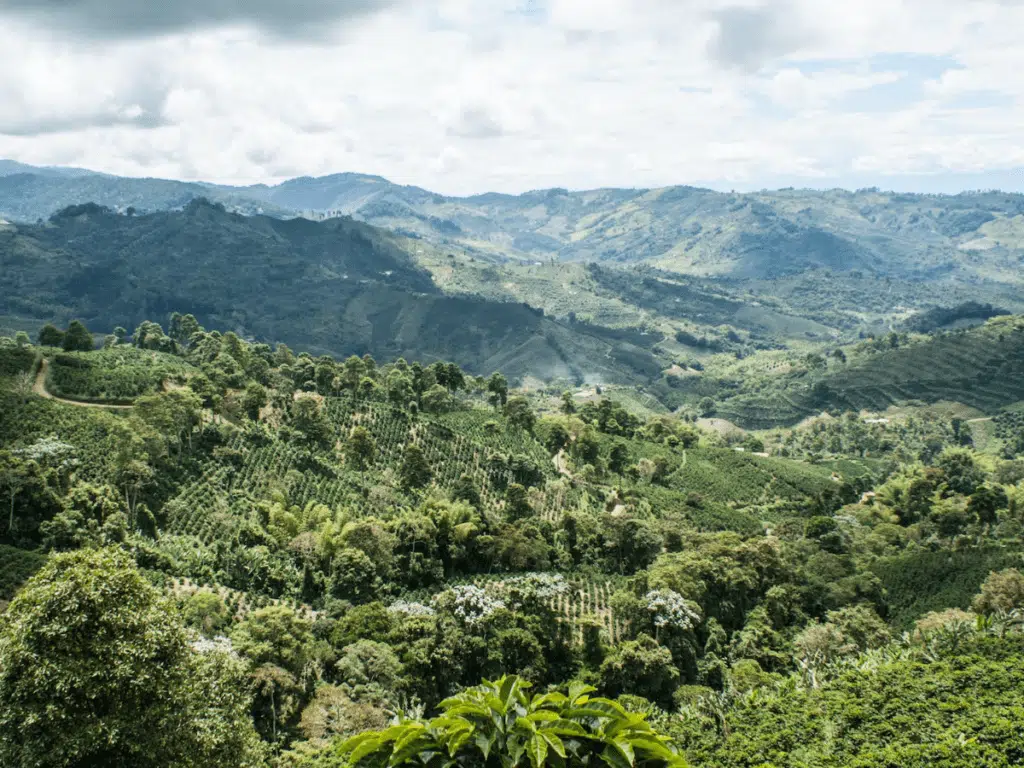
Best South America Backpacking Routes
Backpacking Argentina
Argentina is such a beautiful country, and it’s not for nothing that so many backpackers and travelers choose to explore the region of Patagonia, which offers some of the most stunning landscapes you’ll ever see.
Added to a few days in the capital, Buenos Aires, and you’ve got yourself a perfect route that combines city and countryside views with mind-blowing natural scenery (some of which can be enjoyed even by non-hikers). You’ll even find that Argentina has nice beaches!
Backpacking Argentina Route
Buenos Aires / El Calafate / El Chaltén / Bariloche / El Bolsón
Before heading to Patagonia, spend some time in the vibrant city of Buenos Aires.
You can easily spend 4-5 days or more in Buenos Aires, as it offers dozens of things to do and see. Things to do in Buenos Aires include exploring the San Telmo Market, admiring the Casa Rosada (‘Pink House’ – from where Juan and Eva Perón delivered their famous speeches), wandering the colorful La Boca neighborhood, and visiting MALBA .
From Buenos Aires, you can also take a day trip to the city of Tigre, which lies on the Paraná Delta, or a day trip by ferry to the charming Colonia Del Sacramento in Uruguay.
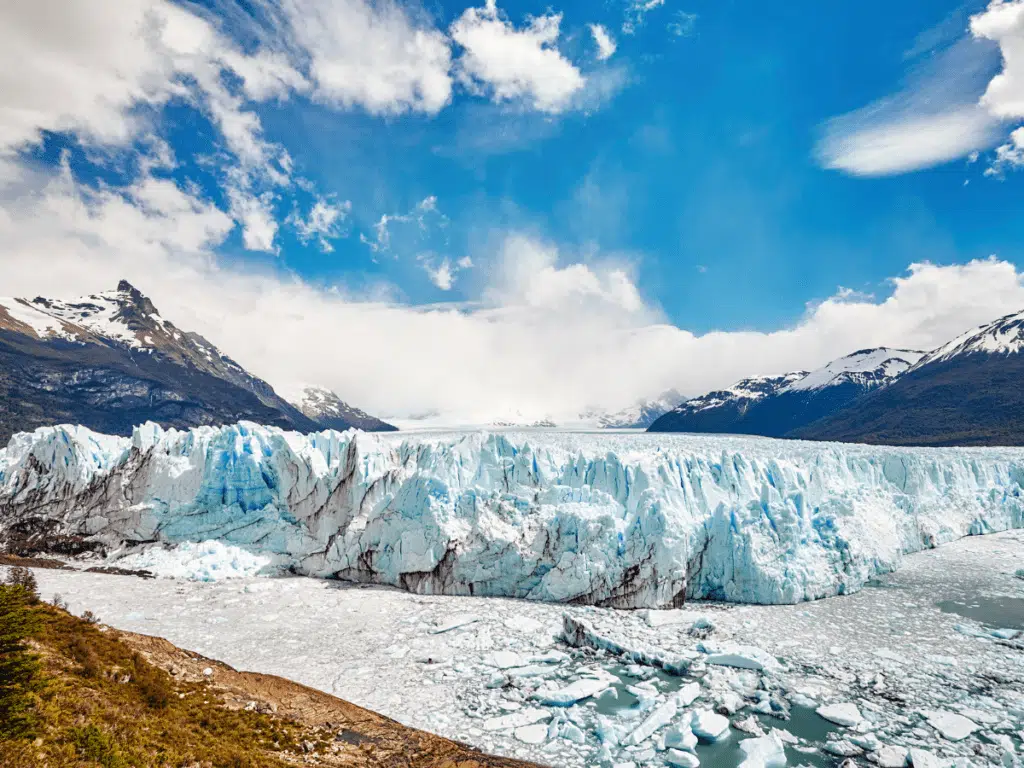
Argentina is HUGE, so getting to Patagonia from Buenos Aires will take you a long time by bus unless you don’t mind splurging on a direct flight. If you want to keep your budget low, you can travel by bus from Buenos Aires to Bariloche and take another bus to El Calafate – it’ll take you about two days to get there.
In El Calafate, the highlight is, of course, taking a tour to see the Perito Moreno glacier, one of South America’s most famous landmarks, which is jaw-dropping.
Next, a 3-hour bus ride will get you to El Chaltén. This is a fantastic place to take some scenic day hikes, though some of them can be a bit challenging, and the constantly changing weather can make the difference between a fun day and an annoying day.
Be sure to hike to the iconic Mount Fitz Roy, Laguna Torre, and Mirador De Los Condores, and for something more relaxed, take a short hike or walk to the Chorillo del Salto waterfall.
From El Chaltén, you can catch a bus to El Calafate, and from there, another bus to Bariloche, which will take you about a day. Bariloche will surely be your favorite stop on this route. It has an adorable city center, the Argentinian capital of ice cream and chocolate, and it’s surrounded by beautiful nature, easily reachable by public transport.
Start with visiting Cerro Campanario, an amazing mountaintop overlooking the Nahuel Huapi National Park. You can either take the funicular or take a 30-minute hike (short but intense) to get there.
Next, take the easy yet scenic Cerro Llao Llao hike, visit the Cascada de los Duendes waterfall, and relax on Gutierrez Lake. You can also rent a car for a day and follow the popular Seven Lakes Route. Stay at the laid-back Tangoinn Downtown Hostel, which offers both private rooms and dorm rooms with an ensuite bathroom.
Last but not least, a 2-hour bus ride will get you from Bariloche to El Bolsón, which also offers plenty of hikes. One that’s a must is the El Cajón del Azul hike, which passes alongside the mesmerizing turquoise Azul River.
Continue your journey on through Chilean Patagonia, just over the border, or back through the rest of Argentina from there. Santiago, Chile is another international travel hub for flights home or to continue traveling on from there. Check out this guide to the best things to do in Santiago to enjoy this incredible city.
Contributed by Or from My Path in the World
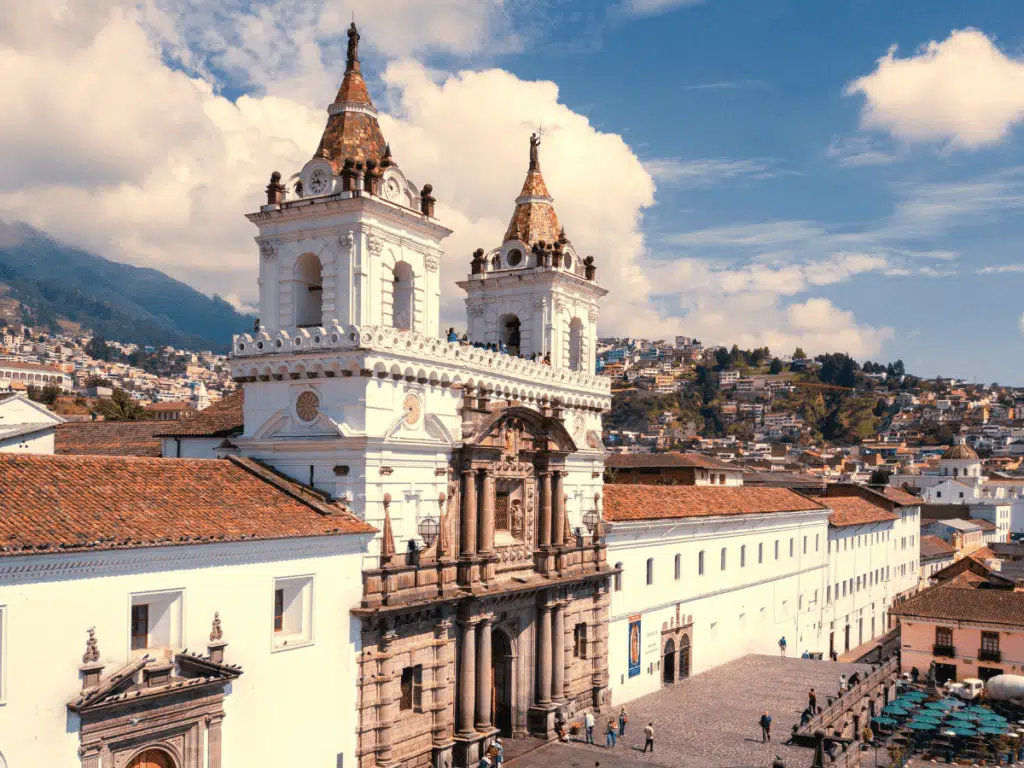
Backpacking Ecuador
Ecuador is a backpacker’s paradise. Packed within this small country are countless unforgettable bucket list destinations. From trekking in the Andes and climbing a volcano to exploring the Amazon Rainforest and historic colonial churches, Ecuador is a must for backpackers – no matter what type of travel interests you!
Check out our Ecuador backpacking guide and our Quito backpacking guide for more!
Backpacking Ecuador Route
Quito / Cotopaxi / Mindo / Otavalo / Tena
Start your backpacking experience in Quito, Ecuador. Quito is a fantastic base for backpackers, and many end up sticking around for months at a time, using the city to explore nearby areas with day trips and weekend trips. You’ll want to use your time in Quito to explore the Quito Historic Center, check out local markets, hang out in the many parks, and hike a volcano or two.
You’ll certainly want to take your time to explore Quito and all it has to offer. It’s even a great spot for digital nomads, and many end up staying in Ecuador for years because of the conveniences it offers for remote workers.
However, there is so much to see and do outside of Quito as well. There are countless day trips from Quito worth considering, but a must on any Ecuador itinerary is a trip to Cotopaxi National Park.
Take an organized day trip to Cotopaxi from Quito, or even better, spend a few days at the Secret Garden Cotopaxi hostel – this incredible hostel runs great, inexpensive tours throughout the park, serves the most delicious food, and even offers free treks to hidden waterfalls. It’s my favorite hostel I’ve EVER stayed it.
After spending time in the national park – and maybe even summiting Cotopaxi! – head to Mindo, Ecuador’s small town paradise located in the Cloud Forest. There are so many things to do in Mindo to keep you busy for several days, from ziplining and birdwatching to river tubing and repelling down waterfalls.
Next, head on via bus from Quito to Otavalo. Otavalo is home to the world-famous Otavalo Market, the largest indigenous market of its kind in all of South America. You’ll want to make sure you visit on Saturday, which is the biggest market day.
Use Otavalo as a base to explore northern Ecuador, including El Angel National Park, Cuicocha Volcanic Crater, and more.
Finally, end your backpacking route in Tena, the gateway to the Amazon Rainforest. Tena is a great spot for backpackers because you’ll find a lot of inexpensive rainforest tours, even multi-day tours and kayaking or whitewater rafting tours of the rainforest.
I’d recommend staying at Hostal Pakay– this incredible hostel will make you feel like you’re in the middle of the jungle, even though you’re just on the edge of town.
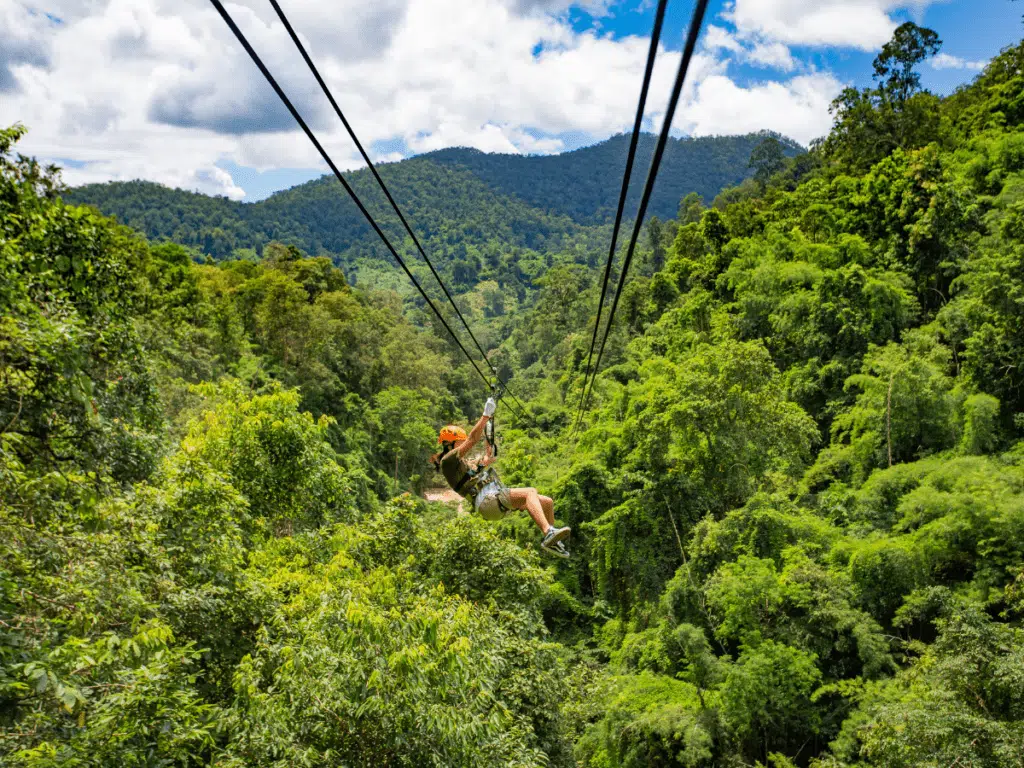
Backpacking Argentina and Uruguay
Often overlooked by tourists and travelers, Uruguay is a gem of a place to visit and a great place to kick off a fun and easy backpacking trip. If you’re planning to visit Argentina, consider starting your trip in Uruguay instead, before embarking on a quick ferry ride to Buenos Aires.
Once in Argentina, there are endless options for extensions to this South America backpacking itinerary, from the Mendoza wine region to the unforgettable Argentine side of Patagonia to the Iguazú waterfall along the Brazilian border.
Backpacking Argentina and Uruguay Route
Punta del Este / Montevideo / Colonia / Buenos Aires
When you arrive in Uruguay, likely via Montevideo’s international airport, you can either rent a car or take a bus to Punta del Este, known as the “Monaco of South America.” If you visit during the off-season, you’ll have the city all to yourself, and can book rooms at hotels and hostels for unbelievably low prices.
If traveling in high season, beware– it can get very crowded and very pricey.
Prior to entering the town, be sure to stop at Casapueblo, the delightfully whimsical house-turned-museum of famed Uruguayan artist Carlos Páez Vilaró, with unbeatable ocean views.
In Punta del Este, walk along the oceanfront, and don’t miss the beachfront sculpture La Mano, considered the symbol of the city, depicting five fingers stretching from the sand.
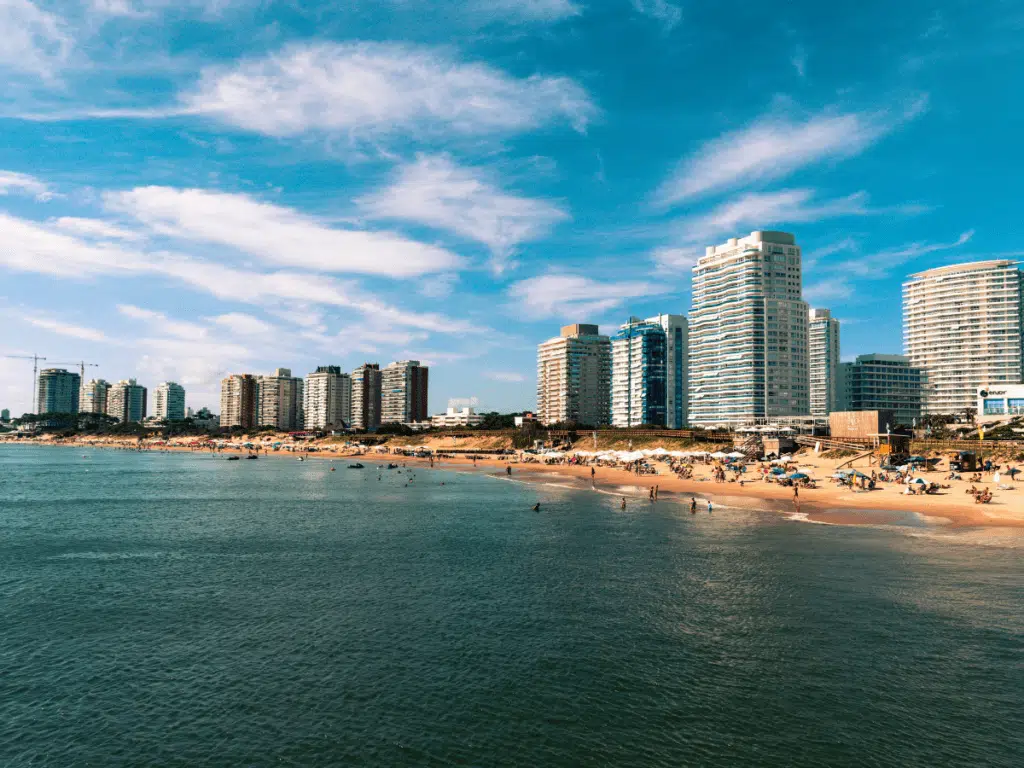
Once back in Montevideo, take advantage of a Free Walking Tour, a tip-tour that meets in Plaza Independencia at 10 AM and 3 PM each day. This tour will take you to all of Montevideo’s most important Ciudad Vieja sites, and takes about 3 hours, ending at the neat Mercado del Pueblo area.
Be sure to check out the Mercado de Artesanos (one of the best markets in Latin America!), and don’t miss trying Uruguayan specialty yerba mate – not just a hot tea, but a national obsession. For some quality walking, people-watching, and ocean views, explore the Rambla of Montevideo, a paved promenade spanning the whole south coast of the city.
The next morning, get an early start to board your bus at Montevideo’s Tres Cruces terminal to Colonia de Sacramento, an adorable colonial town with historic architecture. Its historic area, or Barrio Histórico, is a UNESCO World Heritage site, with original architecture from back when Uruguay was a Portuguese colony and cobblestoned streets dating back to the 17th century.
Colonia is absolutely worth a visit in and of itself, but it is also the jumping-off point for ferry service to Buenos Aires.
The ferry is the easiest way to get to Argentina from Uruguay and is a neat addition to any South America backpacking route. Prior to boarding, you will go through passport control and an airport-style screening, so be sure to leave plenty of time for this when you’re walking around Colonia.
The ferry to Buenos Aires only takes about an hour and drops you off in the recently-revitalized Puerto Madero area of the city.
Buenos Aires is a vast and sprawling city that you could explore for years and not run out of things to do. Starting in the Puerto Madero area, explore its trendy bars and restaurants, and be sure not to miss the Puente de la Mujer, a bridge dedicated to Argentine women through history.
You also can’t miss the San Telmo neighborhood, the oldest neighborhood in the city. The vintage architecture, cute storefronts, and neighborhood plazas are less popular than other parts of the city with tourists and are so lovely and relaxing. It’s also a popular place to stay in Buenos Aires.
San Telmo is very close to the Plaza de Mayo, which is not only the seat of the Argentine government, where important buildings such as the executive mansion, La Casa Rosada, and the Cabildo – the seat of city government, are located, but also an important meeting point for social justice rallies and protests throughout Argentine history.
Other areas of note are the Recoleta and its jaw-dropping cemetery of the same name; the swanky Retiro neighborhood with its luxury mansions; Palermo, a more “hip” area with many great budget places to stay and a beautiful Japanese garden complex (called Jardín Japonés); and the La Boca area, home to the infamous Caminito, the birthplace of tango.
Backpacking South America isn’t complete without visiting this incredible city!
Contributed by Tegan + Alex from Why Not Walk Travel Guides
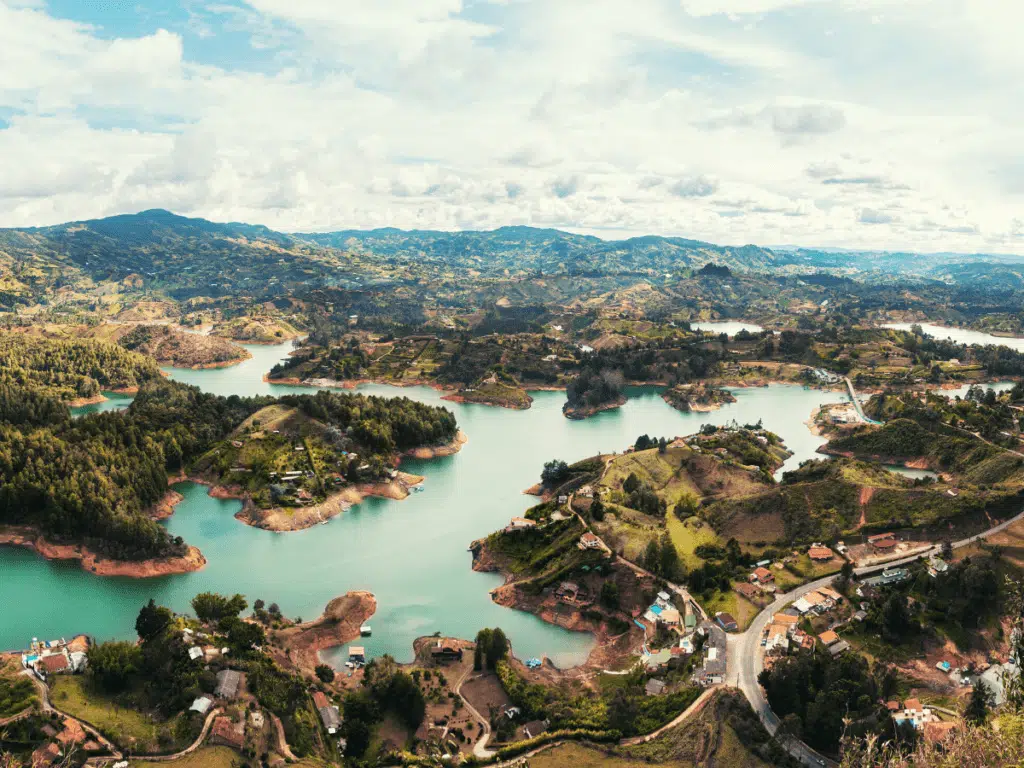
Backpacking Colombia
Colombia is one of the most diverse countries in South America. It has lush green jungles, charming colonial towns, exotic Caribbean beaches, and bustling cities – perfect for a mixed and exciting South America backpacking route.
And all of that can be visited with a 3-week itinerary for Colombia!
Backpacking Colombia Route
Bogotá / Villa de Leyva / San Gil and Barichara / Valle del Corora / Medellín / Cartagena
Start and end your trip in Colombia’s capital Bogotá and enjoy its street art and try Colombian cuisine. Visiting the Gold Museum is free and one of the best ways to learn more about Colombia and its indigenous cultures.
From Bogotá, you can easily explore some of the idyllic towns and small cities located nearby in this mountainous area of Colombia, left off of many speedy travelers’ itineraries but well worth a visit.
Villa de Leyva is a colonial gem and favorite city in Colombia a few hours north of Bogotá, with a huge central square, charming houses, and mountain hikes to keep you busy for a few days.
Continuing north, San Gil is the adventure capital of Colombia, offering you the opportunity to enjoy many adventure activities like parasailing or rafting. A day trip – or longer – to nearby Barichara is a fantastic excursion as well.
This village is picture-perfect with its colonial white houses and day-hike opportunities, like the 2-hour Camino Real trail to charming Gaune.
Next, travel back through Bogotá then make your way to one of Colombia’s big highlights: Valle del Cocora. While there is no direct bus from Bogotá to Salento (you’ll have to travel through the city of Armenia), it’s well worth the trip!
This palm-tree-dotted valley is a stunning place to go hiking and another of Colombia’s best hikes. Visiting one of Colombia’s coffee farms is also a great thing to do in Salento, with plenty of options nearby.
From Salento, travel to Medellín, one of Colombia’s biggest cities, and a must on this Colombia itinerary and a backpacking South America hotspot. Join one of the free walking tours to learn about its history and use the cable car to see the colorful Medellín suburbs from above.
A day trip with the public bus to nearby Guatapé is an easy and beautiful excursion from the city as well. It’s one of the most colorful villages in Colombia and climbing the El Peñón rock offers stunning views of the lake area.
You can’t come to Colombia without experiencing the coast, so next head to colorful Cartagena. Wander around the charming streets, enjoy the tropical temperatures and learn more about Colombia’s history. Visiting the San Felipe castle will give you a great insight into the area’s colonial history.
From Cartagena, there are plenty of ways to continue traveling onward in Colombia, including traveling along the famed Caribbean coast of the country to visit such destinations as Palomino or Tayrona Park.
You might want to add the well-known Ciudad Perdida hike to your itinerary as well, also nearby. This hike takes several days, leading you deep through the jungle to visit the ruins of an ancient indigenous city.
End your trip in Bogotá, preparing to fly home. If you wish to extend your trip, you could explore other Colombian destinations like southern Cali and backpack South America further south to Ecuador or Peru.
Contributed by Maartje & Sebastiaan from The Orange Backpack
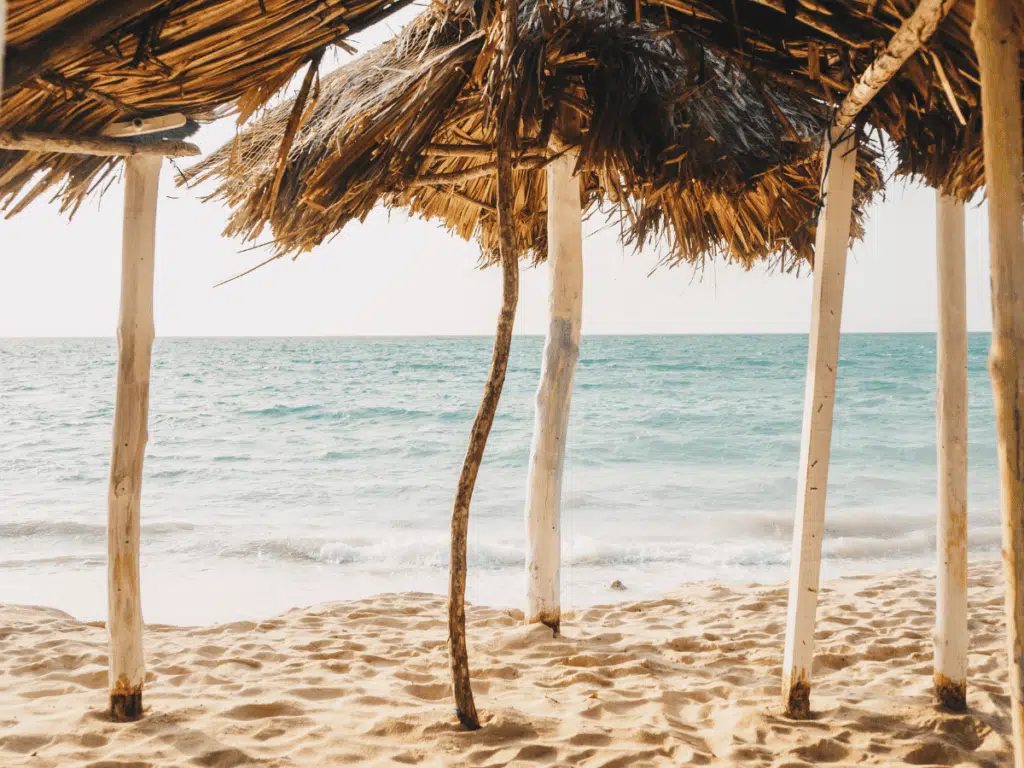
Backpacking Colombia’s Caribbean Coast
Colombia is one of the most bio-diverse countries in South America and can offer you a range of different experiences that can make any South America backpacking itinerary one to remember.
Depending on where you start your trip in Colombia you can have a completely different experience. This Caribbean coast itinerary starts in Cartagena – from here you’ll make your way to one of the most northerly points of South America.
Backpacking Colombia’s Caribbean Coast Route
Cartagena / Santa Marta / Taganga / Minca / Palomino / Riohacha / La Guajira
Start your Caribbean coastal itinerary in Cartagena, one of the most romantic cities in Colombia, and it has everything that any traveler could want, no matter what budget you are on. Walk around the walled city and visit Getsemani for a more bohemian neighborhood vibe.
You can find tours to Playa Blanca and other remote islands from Cartagena.
Continue on to Santa Marta – as the second-largest and most popular city on the coast after Cartagena, Santa Marta not only serves as a gateway to the famous Tayrona Park but also gives you the chance to see Parque de Los Novios as well as other bustling attractions dotted around the historic parts of town.
After a visit to Tayrona Park, make sure to visit Taganga. This local fisherman’s village is a must-visit from Santa Marta as you can arrive here by local bus in just 15 minutes.
Get access to beaches such as Bahia Concha, amongst other diving and snorkeling opportunities that you won’t find in Santa Marta. Taganga is one the best places to try local seafood and get a taste of local life.
Also nearby Santa Marta, make sure to visit Minca. With so many things to do in Minca, it is one of the best places for any traveler who wants to escape the city life of the Caribbean and head into the mountains.
You can arrive here by local bus from the Santa Marta market in just 45 minutes. Expect giant hammocks, waterfall visits, and some of Colombia’s finest eco lodgings.
After a peaceful time in the highlands of Minca, you can head over to one of Colombia’s most rustic beach locations at Palomino. Palomino is one of the places where you’ll find adventures such as river tubing or you can rent surfboards and ride the strong waves.
Be sure to go check out Cafe Maria Mulata to catch the evening music vibes.
From the beach, head back to the main road and jump on the coach to Riohacha, the capital of La Guajira region. Here you can find a more scenic beach stretch with a super long malecón sea wall to explore. This is the perfect place to relax for a night to prepare yourself for a trip into the nearby La Guajira desert. Be sure to speak with locals here and grab some of the unique handmade craft items on sale.
Don’t miss the remote and beautiful La Guajira desert in northern Colombia! You will need to make plans for getting to La Guajira desert from Riohacha when looking for the best deals. In the desert, you’ll get the opportunity to meet with the local Wayuu tribe and see some of the most secluded beaches in Colombia such as Taroa beach.
Be sure to purchase a Wayuu bag whilst here as they are the cheapest you’ll find in the whole country.
This itinerary is a perfect mix for backpackers to see the best spots in Colombia’s Caribbean region and get a good mixture of culture and landscapes. From Riohacha, you can get the coach back to Cartagena, where you can travel onward through Colombia or home.
Contributed by Daniel from Layer Culture
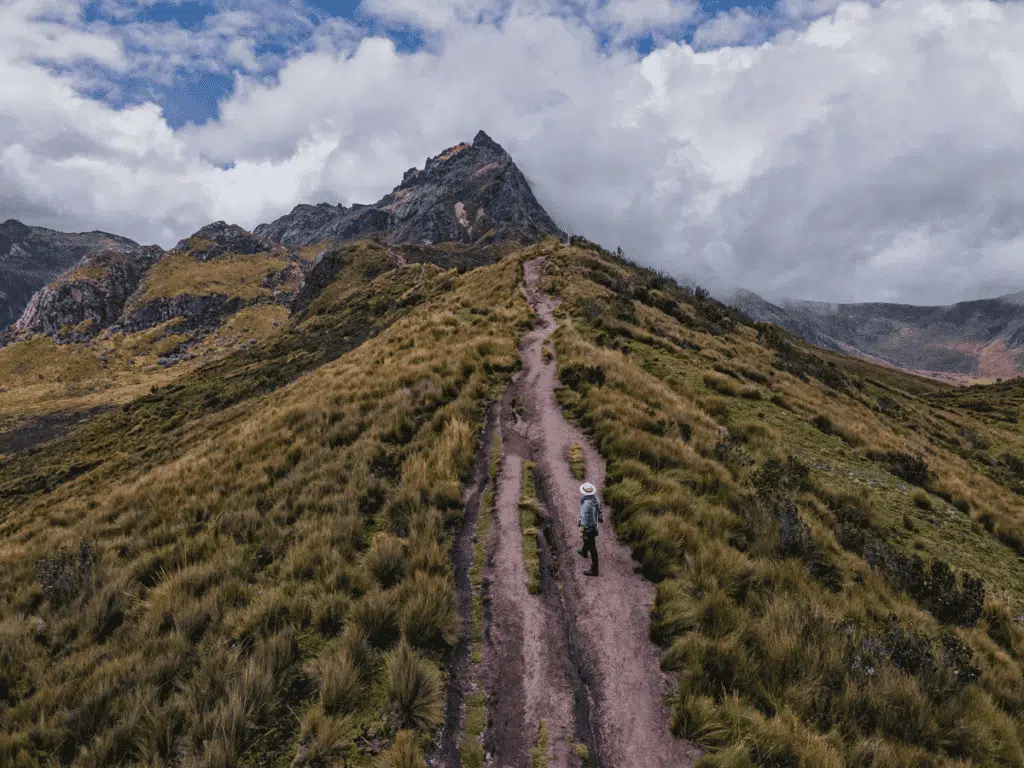
Backpacking Peru
Peru is one of the most incredible and diverse countries in South America and the perfect destination to backpack South America. Although somewhat small geographically, in Peru you will find pristine beaches, the Amazon Jungle, desert sand dunes, historical Inca ruins, and huge towering mountain peaks!
And the best part is you can easily travel between these attractions in a relatively short time to create an epic South America backpacking route.
Backpacking Peru Route
Lima / Huacachina / Arequipa / Cusco / Machu Picchu
Lima is the capital of Peru, and with its large international airport, it’s the easiest place to start your South America backpacking itinerary. Although many people often leave Lima quickly to head to more charming cities in Peru, there is a lot to do and see in Lima.
Go to the beach, learn how to surf, swim with sea lions, go on a food tour, wander the touristic zone of Miraflores, enjoy the vibrant nightlife – the list just goes on and on!
From Lima, head a few hours south to one of the most unique and off-the-beaten-path destinations in Peru: Huacachina. This small town is a desert oasis (literally, it is often referred to as “the Oasis”) where you’ll find hotels, restaurants, bars, and stores all centered around a lake in the middle of massive sand dunes that rival those in the Middle East.
This is the desert region of Peru that many never know exists and it is incredible – completely unique as you backpack South America!
Huacachina is very small so you only need to spend a couple of days here to experience all the best things to do in Huacachina. Be sure to go for a dune buddy ride and try your skills at sandboarding! Also, the Wild Rover Hostel is known for its massive pool parties every afternoon that continue on well into the middle of the night.
Continue on to Arequipa, one of the most beautiful cities in Peru. The historic buildings and cobblestone streets make every turn picture-perfect. Joining a free walking tour in Arequipa is one of the best ways to explore the city and learn about its rich history.
Although the city is gorgeous, the most popular activity in Arequipa is actually just outside of the city, hiking the Colca Canyon. You can visit this huge canyon on a day trip, or if you have time, hike deep into it on a 2 to 4-day guided hiking trip from Arequipa.
Venture inland from Arequipa to visit Cusco, a must on any backpacking South America bucket list. Cusco is the gateway to Machu Picchu and a fascinating city! With Inca ruins scattered around the main plaza, there is so much history in Cusco!
There are also tons of markets, shopping, amazing Peruvian restaurants, day trips and tours to choose from, and wild nightlife. Some of the most popular day trips from Cusco are visiting the Sacred Valley and Rainbow Mountain. You can’t miss these stops while backpacking through South America.
Machu Picchu is one of the Seven Wonders of the World and worth its reputation and fame. You can choose to visit on a day trip from Cusco, or you can challenge yourself to a multi-day hike to get there. The Inca Trail is the most famous trail but also the most expensive.
For a great alternative, try the Salkantay Trek. This hike is usually completed over five days with the last day spent at Machu Picchu. It is a somewhat challenging trail though, so if you aren’t an experienced hiker, be sure to be prepared with essential hiking tips for beginners before you set off.
No matter how you choose to get there, you’re sure to be amazed by Machu Picchu – it’s one of the most iconic places to visit in all of South America!
Contributed by Bailey from Destinationless Travel
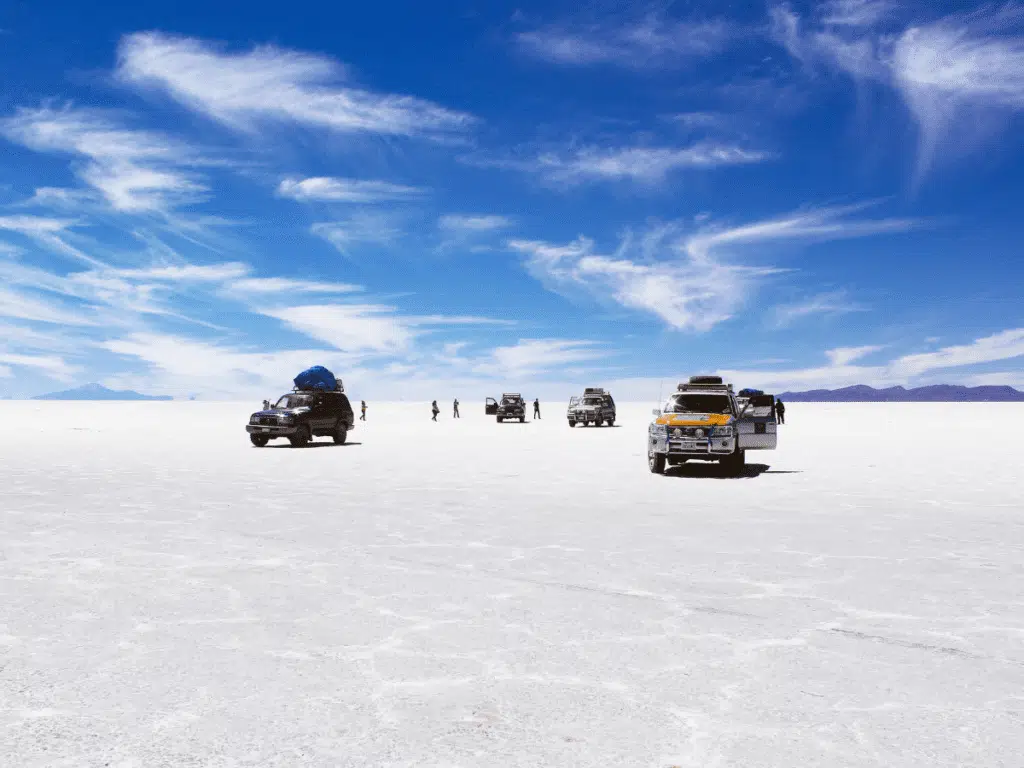
Backpacking Peru and Bolivia
Peru and Bolivia are some of the best countries for backpacking through South America. Here you’ll find amazing activities, interesting historical sites, unique cultures, and friendly people.
It’s very easy to move around inside and between these countries using public buses that connect the main tourist attractions.
To backpack South America from Cusco in Peru through Bolivia to the Atacama desert in Chile is an incredible experience with many world-famous attractions such as Machu Picchu, Colca Canyon, Titicaca Lake, Uyuni Salt Flats, and the Atacama Desert.
The diversity of landscapes, wildlife, and cultures on this route is truly spectacular.
Backpacking Peru and Bolivia Route
Cusco / Arequipa / Titicaca / La Paz / Uyuni / Atacama Desert
Start your trip in Cusco, the ex-capital of the Inca Empire. If you’re planning to do some hiking around Cusco it’s highly recommended to stay in Cusco for a couple of days to acclimatize.
There are many interesting attractions to see in and around the city to keep you busy. As for adventure activities, Cusco can be named the hiking capital of South America.
From the famous Inca Trail that takes hikers to stunning Machu Picchu to lesser-known routes like the Choquequirao or Ausangate treks, or the jungle treks through the rain forest. Hiking is not the only activity in Cusco you can do paragliding, rafting, horseback riding, mountain biking, and more.
Cusco is a gateway to Machu Picchu, the Inca ruins that are considered one of the seven modern wonders of the world. Of course, a visit to Machu Picchu is a must-do thing in Cusco.
Read More: Best Machu Picchu Tours (For Every Budget!)
From Cusco, travelers can head to the coast to Arequipa, another beautiful city in Peru with a fantastic historical center and many great things to do. A day trip to the Colca Canyon is a not-to-miss activity near Arequipa. The impressive canyon is one of the best places in South America for watching magnificent condors. These massive birds glide above the canyon searching for food. It’s possible to do a 2-day hike in the canyon and stay in an oasis at the bottom.
Travel through Puno in Peru through Lake Titicaca, famous as the highest navigable lake in the world. The lake is located at nearly 12,500 feet / 3,800 m above sea level on the border between Peru and Bolivia. Doing a boat trip on the lake, stopping at one of the “floating islands” and staying overnight on Isla del Sol with a local family is a truly unique experience.
La Paz, the bustling Bolivian capital is a great stop on the way from Titicaca to Uyuni. La Paz is the highest capital city in the world at an altitude of 11,500 feet / 3,500 m.
It offers a great backpacking scene with many hostels, cheap local eateries, interesting markets (the Witches Market is one of Latin America’s best markets!), and impressive murals.
La Paz is one of the favorite backpackers’ cities in South America for chilling out in between long bus rides and adventure activities. Check out Selina La Paz or The Nest Boutique Hostel for great places to stay in the best part of the city.
If you want to try real climbing and conquer one of the highest peaks on the continent head to Huayna Potosi mountain. It’s one of the most accessible mountains over 19,600 feet / 6,000 m in the world.
Uyuni Salt Flats is definitely one of the highlights of South America. The salt desert always looks impressive, but during the rainy season, its surface turns into one massive mirror that reflects the blue sky and clouds, creating a surreal landscape.
There is no public transport going through the desert, so joining a tour is the most popular way to explore the area. If you’re adventurous enough you can cycle across the desert, though you must be prepared very well, it’s a tough journey.
From Uyuni, you can cross to the Atacama desert in Chile, the driest place on earth. Visiting the bizarre landscape of the desert with multiple colorful lagoons is a unique experience.
There are many amazing things to do in the Atacama, including cycling in the desert, sandboarding, star gazing, floating in salt lakes, watching flamingoes, or driving a dune buggy.
Contributed by Campbell and Alya from Stingy Nomads

Carley Rojas Avila is a bilingual New York-based travel writer, editor, content marketer, and the founder of the digital travel publications Explorers Away and Home to Havana. Carley is an expert on all things Latin America, the Caribbean, and Cuba, having lived and worked in four different countries in the region. Her writing has appeared on the Associated Press wires and in Travel + Leisure, Yahoo, MSN, Euronews, The Weather Channel, and more. When she's not writing about her travels, find her front row at a Bad Bunny concert, befriending street cats, and taste-testing every pizza in Havana.

